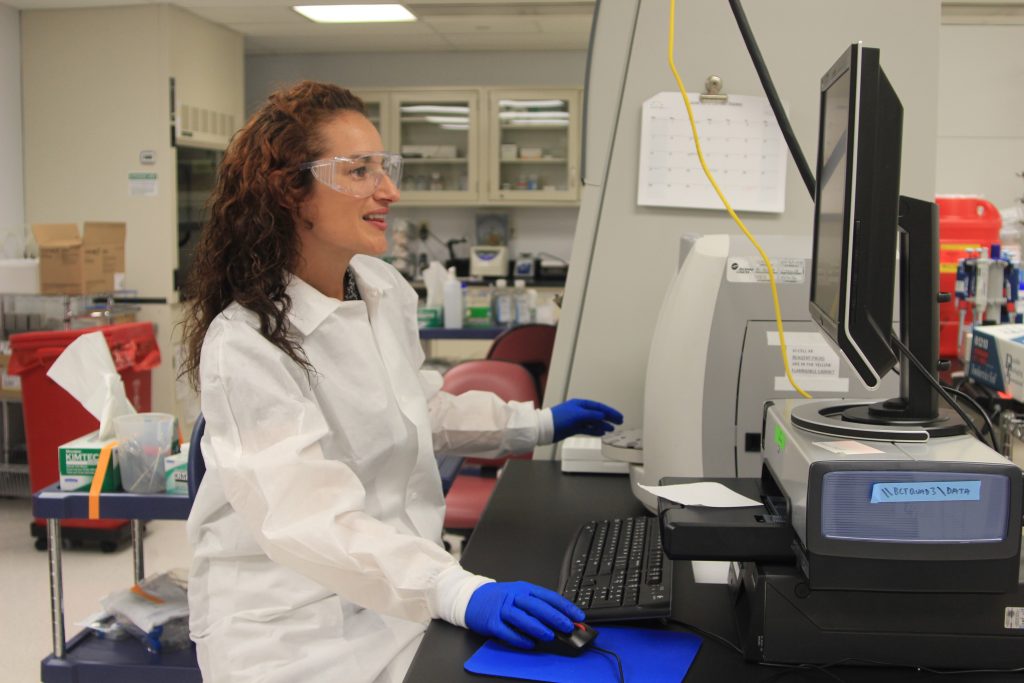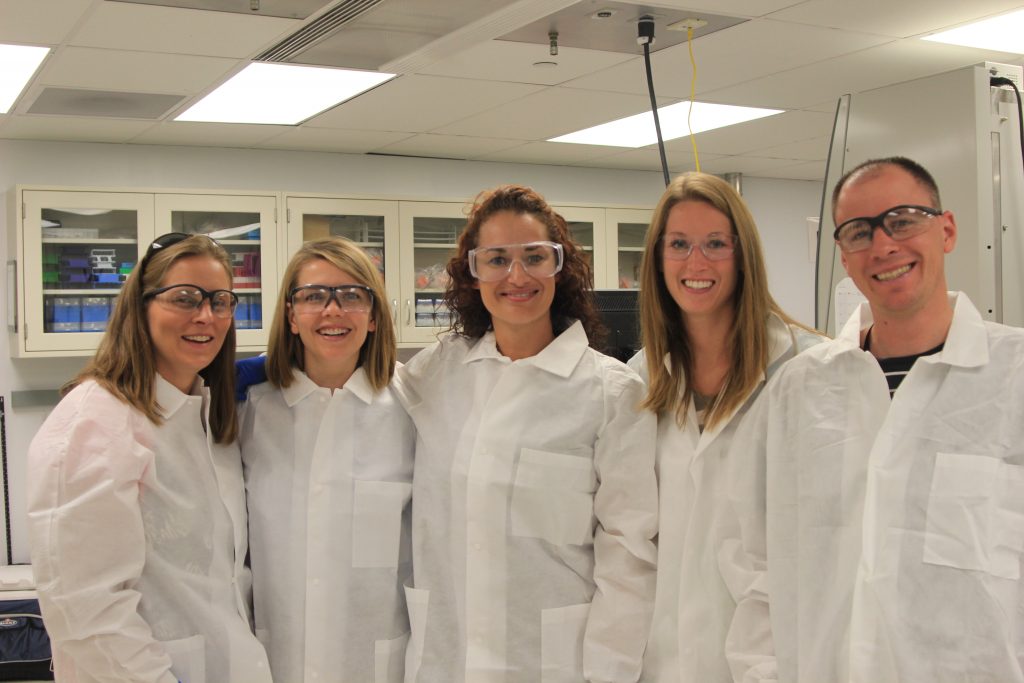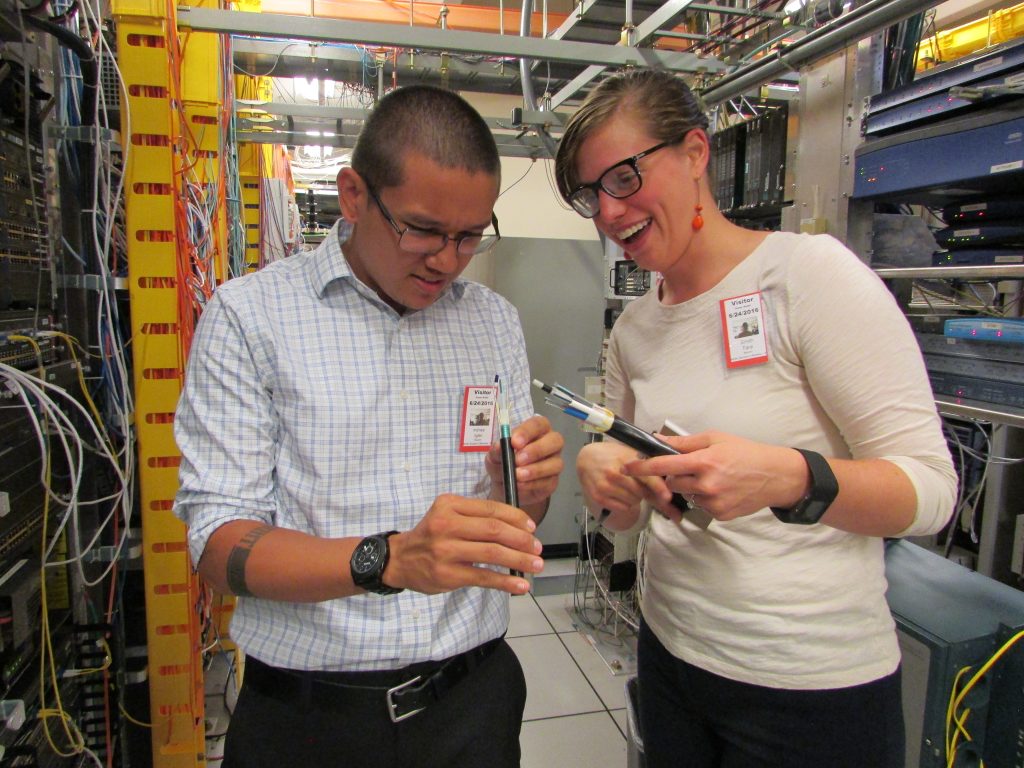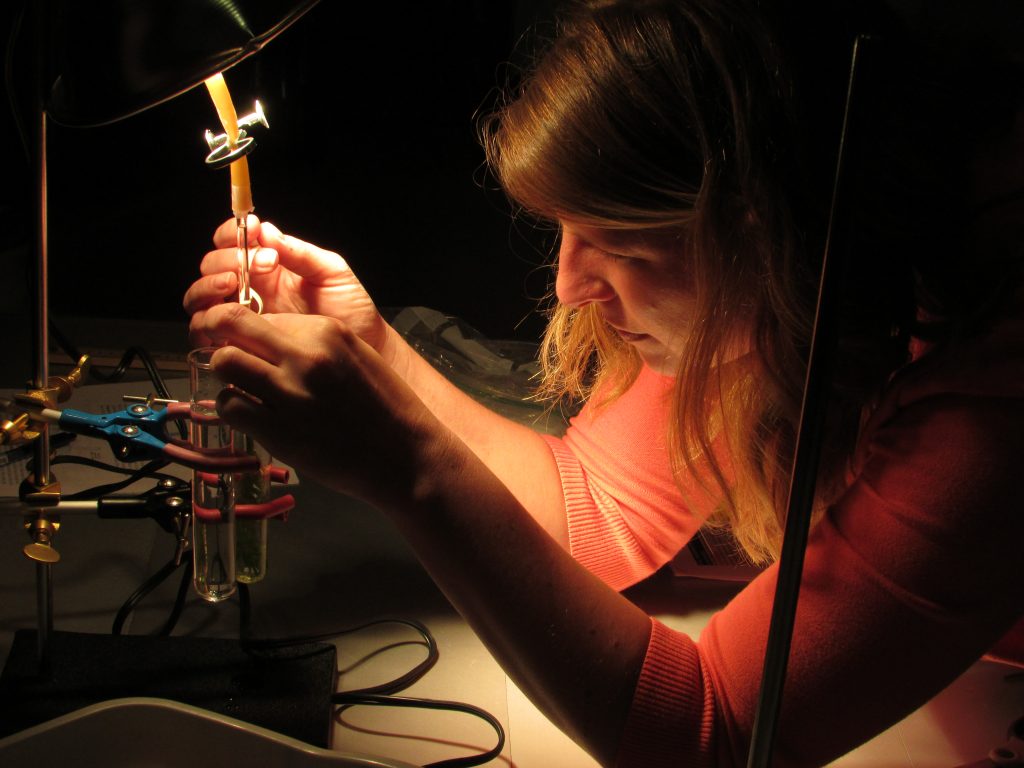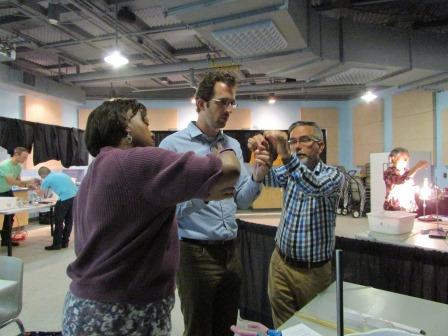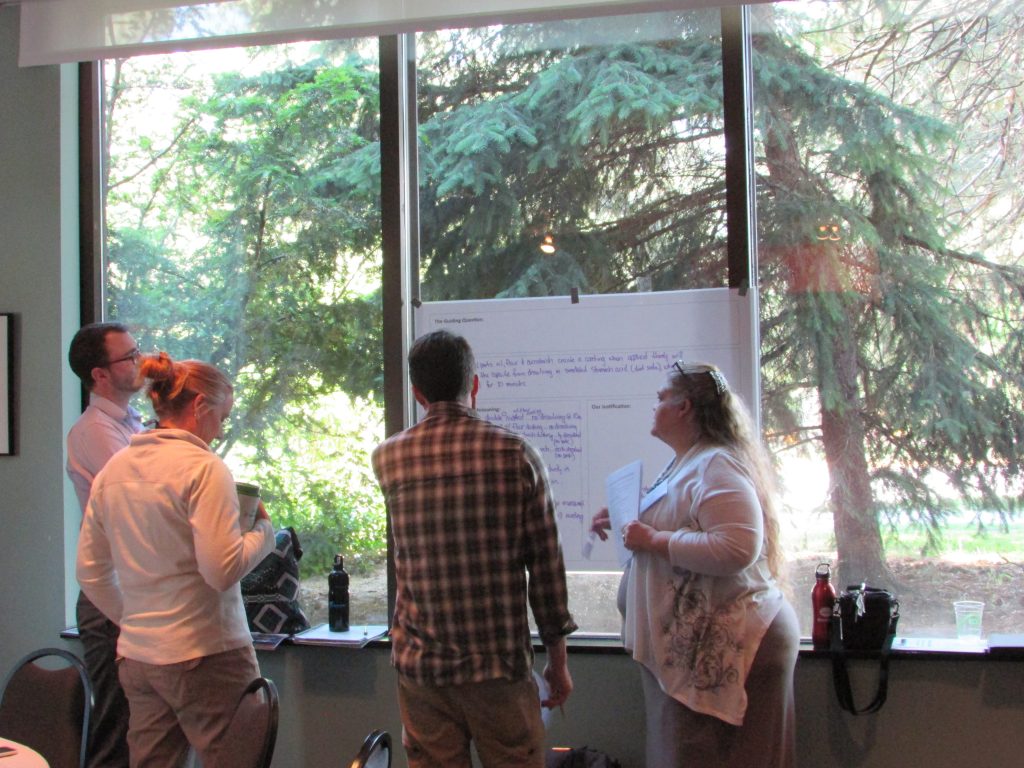Feature
Changemakers
STEM Education Coming to Life Through Collaborative RET Partnerships
Connected Science Learning November 2016-January 2017 (Volume 1, Issue 2)
By Robert Payo and Meg John

Through a business funded collaborative, this Research Experience for Teachers program involves businesses, schools, and a museum to give teachers first-hand knowledge of what it’s like to do science in the corporate research world by giving them the opportunity to work with scientists in their labs. The museum partner assists the teachers to translate what they do in the research lab into their classroom practice, building student understanding of science, creating experiences for students to think and work like scientists, and highlighting potential pathways to STEM-related careers.
Stephanie Spiris is a 12-year veteran teacher at George Washington High School in Denver, teaching courses in biomedical science (Figure 1). Last year, Spiris spent four weeks in a summer internship at Terumo BCT, a medical device company that focuses on blood processing for medical treatment and care. Decked in full lab gear and ready to learn, Spiris worked in a sterile lab, conducting projects that allowed her firsthand experience with tasks such as separating t-cells from blood and freeze-drying plasma.
Figure 1
High school teacher Stephanie Spiris works with scientists at Terumo BCT, a medical device company in Lakewood, Colorado.
Experiences such as Spiris’s, often referred to as Research Experience for Teachers (RET) programs, give teachers firsthand knowledge of what it’s like to do science in the real world by giving them the opportunity to work with scientists in their labs. Teachers seek out these experiences not only for themselves but also for how these experiences translate to the classroom. RET programs can help teachers in their efforts to build student understanding of science, create experiences for students to think and work like scientists, and highlight potential pathways to STEM-related careers. A Framework for K–12 Science Education focuses on science and engineering practices, underscoring “the importance of developing students’ knowledge of how science and engineering achieve their ends while also strengthening their competency with related practices” (NRC 2012).
Of her RET program experience, Spiris states, “It was an incredible opportunity for me to learn what goes on outside of the classroom, to see real science, but most importantly to make those lasting connections for my students and to really create opportunities for them. I had the opportunity to work on projects that aren’t even in the pipeline yet, projects that are in the early stages of development.”
Science teachers’ participation in RET programs have been shown to improve their knowledge, beliefs, and classroom practices regarding inquiry-based instruction (Miranda and Damico 2015), as well as student achievement in the sciences (Silverstein et al. 2009).
But for teachers like Spiris, access to these types of opportunities for professional growth require a coordinated pathway that connects collaborative partners of the formal and informal education community with those of STEM business and industry, in the case of this article, primarily in the biosciences. RET programs can provide a doorway for using the assets of each partner as these relationships are built and cultivated.
What would you need to consider when building a RET program? What models work best? How do you go about determining measures of success? We’ll look at these questions when examining the work of a Colorado RET program to paint a picture of what we’ve learned so far, make suggestions for those creating or expanding upon a RET program, and show how change can occur through powerful, collaborative STEM partnerships.
Using Intermediaries to Facilitate Collaboration
Each party in a RET program brings expertise, strengths, and limitations that must be considered for a successful partnership to emerge and sustain itself. Table 1 shows some of the roles and considerations within a RET program partnership that specifically involves informal and formal education organizations working in collaboration with companies or corporations.
As with any collaboration, partners in a RET program come to the table with their own needs, culture, priorities, and systems for conducting business. Because of this, it is essential to have someone play the intermediary role of coordinating the partners and brokering the relationships of the people involved. Depending on the circumstances, this role can fall under any number of people in an organization or can even be shared across organizations. For example, in the formal education world, this role could be designated to a university faculty member or the outreach program coordinator of a research lab. For informal organizations, a museum educator or a coordinator of partnerships could be a good fit for this role. As an alternative, having a nonprofit organization at the helm of the RET program may allow access to grant and foundation funding not available to schools or industry.
Since school systems and industry usually don’t have staff dedicated to such roles, those involved in building the RET program will need to find individuals who are up to the task. Why take on this role? Typically, organizations that implement RET programs do so as a means of fulfilling their mission to further improve STEM education. Facilitating effective communication among all parties involved ensures that each organization’s goals and priorities are taken into account. Ideally, this role should be filled by a person (or several people) who can dedicate a significant portion of time to cultivating and maintaining these relationships—someone who can speak across the gap of the classroom and the professional organizations to best meet everyone’s needs.
| Partner | Key Players | Primary Role in Partnership | Strengths and Advantages | Limitations and Considerations |
|---|---|---|---|---|
| Formal Education | • District level administrators • STEM coordinators • Instructional coaches |
• Teacher recruitment • Teacher follow-up and professional development |
• Can select teachers suitable for RET experiences • Can provide input and feedback for professional development being delivered • Can cultivate leadership in RET teachers within a district |
• Access to funding support for the program • Potential for varying response time in addressing issues and needs • Ability to provide a commitment to and vision for supporting teachers after their RET experience |
| Formal Education | • Teachers | • RET participants who create learning experiences to take back to the classroom and actively participate in teacher training | • Offer industry new perspectives outside of their world • Provide industry with an avenue for community relations and career awareness |
• Limited time to plan and meet with industry partners • Varied levels of willingness and openness to change teacher practice based on RET experience |
| Informal Education* *Roles may fall to one person, be shared by several people within one organization, or shared across organizations |
• Project Managers • Program Coordinators • Partnership Liaisons |
• Brokering and maintaining relationships between formal education and industry • Providing support programming such as teacher professional development |
• Act as a liaison, able to understand and interpret the needs of all partners • More flexibility to respond to needs or changes in programming |
• Human resource capacity: Partnerships require significant time and resources to maintain • Fundraising and developing programming is challenging due to the small number of teachers and companies the RET program can serve |
| Business and Industry | • Company Advocate (e.g., HR manager, VP or CEO, Corporate Social Responsibility Liaison) | • STEM site project provider • Primary mentor and supervisor for RET participants |
• Have firsthand experience in current STEM research and technology • Often provide financial support for the program • Provide resources to the classroom (e.g., volunteer guest speakers, arranging field trips) • Host site for meetings and professional development |
• Companies usually don’t have an employee dedicated to supporting RET teachers • Company policies may make hosting teachers challenging • Teacher access to proprietary information and materials must be negotiated • Company may be limited in the number of teachers they can host • Field work is commonly not aligned with classroom science content |
Colorado Bioscience Institute: Case Study of a RET Intermediary
The Colorado Bioscience Association supports the regional bioscience community through advocacy, resources, and advancement of opportunities for collaboration. To support education across the STEM pipeline, the association formed a separate 501(c)3 nonprofit known as the Colorado Bioscience Institute. The Institute’s overall program supports middle and high school teachers through RET experiences, as well as a mentoring program for undergrad and graduate students and leadership and workforce development trainings for science professionals at any stage in their careers. The institute launched its RET program in 2014, and it includes:
- a summer program where teachers spend four weeks (approximately 130 hours) working at innovative STEM companies on real-world projects, and
- 30 additional hours of teacher professional development (24 hours in the summer and six hours in the fall).
The structure of the program was based on a model developed at the University of Colorado at Denver for a former Math and Science Partnership grant with Denver Public Schools as a way of supporting teachers through a lab research internship experience (Basile et al. 2006).
Meg John, the Institute’s Program Director, oversees the RET program. In addition, the Institute contracts with STEM consultants such as the Denver Museum of Nature & Science (DMNS) to support John with the teacher professional development training. The Institute is ideally situated as an intermediary broker between industry and education as it can readily call upon the Colorado bioscience community (or its expanded collaborators in the technology and cleantech industries) to participate in the RET program.
Working Directly With Industry
Typically, RET programs connect to academic university research labs rather than with industry. The Colorado Bioscience Institute’s RET program is unique in that it works directly with industry partners. Another example of an industry/teacher partnership is the Industry Initiatives for Science and Math Education (IISME) Summer Fellowship Program, a program in the San Francisco Bay Area that was founded in 1985. Working with STEM industry partners presents interesting opportunities for teachers to learn about scientific research and the direct application of that research in the business realms of commercial production of items such as better tubing for blood that allows for more efficient flow and prevents clotting.
Meg John pointed out the importance of establishing clear guidelines and expectations for prospective industry partners. “I spend a lot of time talking with industry leaders about what the RET program goals and expectations are, having these conversations very early in the process—often a year or more in advance before a teacher ever steps into a company. This is more than a mentorship where a teacher shadows a researcher or simply learns about the work the company does,” John said. “I emphasize the need for a partnership of mutual benefit, encouraging companies to find ways to capitalize on having the teacher as more of a staff member than a guest. For example, a small company may have a group of engineers that all think the same way. A teacher forces them to think differently and offers fresh perspectives about how companies describe their work, their science, and practices. This perspective can help them better communicate their research and/or products with customers and the general public” (Figure 2).
Figure 2
From left to right: Meg John, Program Director of the Institute; Karis Morrall, Career Connect, Denver Public Schools; Stephanie Spiris, teacher at George Washington High School, Denver Public Schools; Kristina Fuerst, Systems Engineer at Terumo BCT; and Shawn Keil, Laboratory Manager at Terumo BCT.
With clear expectations, mentors and teachers ideally create positive relationships with one another and, as one study indicates, both enjoy greater benefits from the program as a result: The presence of a supportive mentor can influence whether teachers make changes in their teaching practice after their RET experience (Varelas, House, and Wenzel 2005). To ensure that teachers have a safe, positive, and meaningful RET experience, the Colorado Bioscience Institute has established a few guidelines for industry partners to follow. These guidelines are based on the intentions and goals of the program and are reviewed and revised based on feedback from teacher cohorts and their mentors (for more on Industry Partner Guidelines, see Appendix A).
John also recognizes the importance of having company partners that see the RET experience as a way of improving the STEM pipeline, providing teachers with an inside, hands-on view of what the STEM industry is like. She also suggests that it is helpful to work with a company that can place more than one teacher. “Companies that have the capacity to support multiple teachers make placement much easier. Industry partners often have to work out policies of safety, proprietary disclosure, and other issues before onboarding teachers into their labs. This process takes time and effort and being able to place more teachers at once in a company makes everybody’s job easier,” says John. “But, once a company establishes these policies, the onboarding process usually goes faster after the first year and our company partners almost always return to host another teacher beyond the first year.”
Examples of RET Experiences
What type of work do teachers in RET programs actually do? This varies, of course, but companies are asked to provide a specific project or set of work tasks for each teacher that are hands-on and engaging, with the opportunity to work on new research or products that are not yet available to the public (Figure 3). Ideally, within the RET experience, about 75–80% of a teacher’s time is dedicated to STEM research or developing new products and 20–25% is spent on business aspects such as product development and production. In terms of placement and the type of work teachers can do, John encourages industry partners to think along the lines of what college interns might do while taking into account the fact that the program’s teacher participants are established, working professionals, even if that experience is outside of a lab. John states, “I’ve suggested the idea of partnering the teacher with an intern that can complete a given project since college interns tend to stay a longer length of time, usually 10–12 weeks. Or I suggest giving teachers ‘back burner’ projects such as data analysis that they’d like to have done but haven’t had the chance to do yet.”
Figure 3
Tyler Milnes and Tara Smith—engineering teachers from STEM Launch K–8 in Adams 12 Five Star School District—examine a fiber optics sample on a tour at Level 3 Communications, Broomfield, Colorado.
Working With Teachers
The success of a RET program also largely rests on the shoulders of the teachers who participate in them. These teachers must be interested in giving up their summer to work in a nine-to-five professional environment. They must be self-motivated, willing to make changes in their teaching practices, and creative in how they bring their lab experiences to life in the classroom. To support this translation into the classroom, a focus on teacher professional development training in the NGSS science and engineering practices serves as a guideline for teachers to identify how the practices are employed in the real world and how they can be taught in the classroom (Figure 4). At the end of each RET, teachers are paid a $3,000 stipend and are required to produce a classroom learning experience that incorporates the NGSS science and engineering practices and their experience observing and implementing the practices in the field.
Figure 4
Sample outline of the PD plan
Summer Kick-Off Sessions (one day prior to RET experience)
- Day 1: Kick-Off Introduction to the Institute and the RET Program, Meet Participating Host Companies, Introduction to NGSS Practices, Focused Practice Activity
RET Summer Program Sessions:
- Day 2: Host Company Tour, Share Experiences So Far, Deep Dive on One Practice (example: Analyzing and Interpreting Data), time to work on creating learning experience
- Day 3: Host Company Tour, Share Experiences So Far, Deep Dive on One Practice (example: Engaging in Argument from Evidence), time to work on creating learning experience
- Day 4: Host Company Tour, Summer Experience Reflection activity, Learning Experience work time with district coordinator or support
Fall Culminating Session:
- Day 5: Revisit summer experience and how it is currently translating to the classroom, Assessing Practices Activity: How do you know your students got it?, Lab Tour and Presentation, Evaluation: Focus Group Discussion, Looking Forward, Next Steps: How to share experience with students and colleagues and how to re-engage with host company
Teacher Profile: Mandi Ruud
Last year, Mandi Rudd, a nine-year veteran teacher in math and science, had the opportunity to study something she knew would intrigue her students: the microscopic properties present within the skin of sharks. Ruud was a part of the Institute’s 2015 RET cohort, interning at Sharklet Technologies, a medical device company in Aurora, Colorado.
Real shark skin is covered with a micropattern comprised of millions of tiny diamond shapes. Sharklet Technologies is creating a bio-inspired version of this micropattern in synthetic materials. The Sharklet micropatterns have great potential to be used in medical devices that promote proper human bone cell orientation and function, especially with the delicate process of bone growth in spinal fusion surgeries. Ruud worked on a project that investigated the influence of Sharklet micropatterns on cell morphology and how these changes in cell shape impact cellular function. She used standard staining, microscopy, and image analysis techniques to evaluate the elongation and orientation of stem cells grown on Sharklet micropatterns and outputs such as protein and calcium production that indicate whether these changes in shape caused the stem cells to differentiate into bone cells. The results of Ruud’s experiments demonstrated that it is feasible to use Sharklet micropatterns to enhance bone growth.
Ruud also has the distinction of being named as one of the authors on a research paper related to the study. “I feel like an accomplished scientist!” Ruud said. “It helped me understand what it’s like to contribute something to science and gave me a better view of what I am preparing my students for in the future.”
“One of the biggest takeaways from my experience at Sharklet,” Rudd stated, “was seeing the degree of creativity involved within their practice of scientific research. Scientists need to be creative and be a jack-of-all-trades when it comes to developing an assay or engineering ways to test a product. When you are a startup company with new and innovative ideas, you are setting the precedent. [I learned that] everyone involved needs to contribute to the company in multiple ways for it to be successful.” In the classroom, Ruud now has a higher comfort level in making the science and engineering practices more explicit in her lessons and labs. She feels she can employ more open-ended inquiry approaches, challenging students to “think more creatively.” Her participation in the RET program has also resulted in other important outcomes. “I am now less shy about contacting other companies and inviting them to be involved in my classroom. I now know how supportive STEM companies can be towards teachers and that they want to see us succeed,” said Ruud (Figure 5).
As Ruud’s experience attests, these experiences can be profound and the Colorado Bioscience Institute recognizes the importance of preparing teachers for their RET experience before it begins and supporting them afterward by providing professional development opportunities, ensuring that they get the most out of the RET program.
Figure 5
Mandi Ruud, a sixth-grade science teacher from STEM Launch K–8, participates in a photosynthesis activity at the Denver Museum of Nature & Science.
Working With Formal and Informal Education: Teacher Professional Development
With 30 additional hours of professional development, the Institute focuses on providing teachers with instructional models that help them structure and translate their lab experience into the classroom with an emphasis on inquiry-based teaching strategies. Throughout this process, PD facilitators also look for ways to build a stronger community of practice among the teachers. To support these efforts, the Institute contracts with DMNS and a STEM consulting firm, STEM Learning by Design, to facilitate the professional development opportunities.
Currently, Colorado is using science standards developed prior to the NGSS. The Institute’s RET program provides an opportunity to introduce teachers to the NGSS, using the NGSS science and engineering practices as an accessible entry point for teachers to learn about the NGSS.
Students will take cell phone cases and collect data by performing the same test on each case and analyzing the data to decide how to improve the product. They will try out the product themselves and interview another user. They will then make their own prototype using the data and interviews to inform their design.
The teacher who developed this lesson took some of the processes she observed in her RET experience and found a way to translate them for the classroom by using the science and engineering practices to think about how students would interact with one another to create design solutions.
Measured outcomes from a small and localized pilot test of the Institute’s program demonstrated a positive impact on teachers’ knowledge, skills, and self-confidence after they completed the summer program, according to an analysis of pre- and post-program surveys. These outcomes included:
- Increase in use of NGSS science and engineering practices, demonstrated by a 10.9% increase in students asking questions and an 11.4% increase in students engaging in argument from evidence (based on an analysis of lesson plans).
- Increase in confidence teaching scientific research by 22.7% and increase in understanding of the business of scientific research by 29.9%.
The pilot test participants consisted of nine teachers in the program from two school districts with a battery of pre- and post-program teacher surveys, a site-visit rubric, pre- and post-experience student surveys, and company surveys. This past year, the Institute started using a tool to help teachers identify how the SEPs are being employed in their RET experience. While this tool is still in development and not available for public distribution, it is a step toward making the SEPs more explicit so that teachers can recognize what they look like in the field and can ask their company mentor questions to gain a better understanding of the SEPs from an STEM industry development perspective. For example, an industry project in the beginning stages of development may use a lot of initial models to describe and inform a design or research plan. Their investigations begin with a few driving questions to base their research on. Like the engineering design example previously mentioned, these practices are interwoven with one another, so mapping them out and identifying how they are used can help teachers think of ways to make these easier for students to employ. After the first year of using the practices tool, the Institute will continue to refine it since teachers still had difficulty translating what they identified in industry and reflecting more of the SEPs in their curriculum. Further steps are being considered to give teachers more help with scaffolding the SEPs in their instruction.
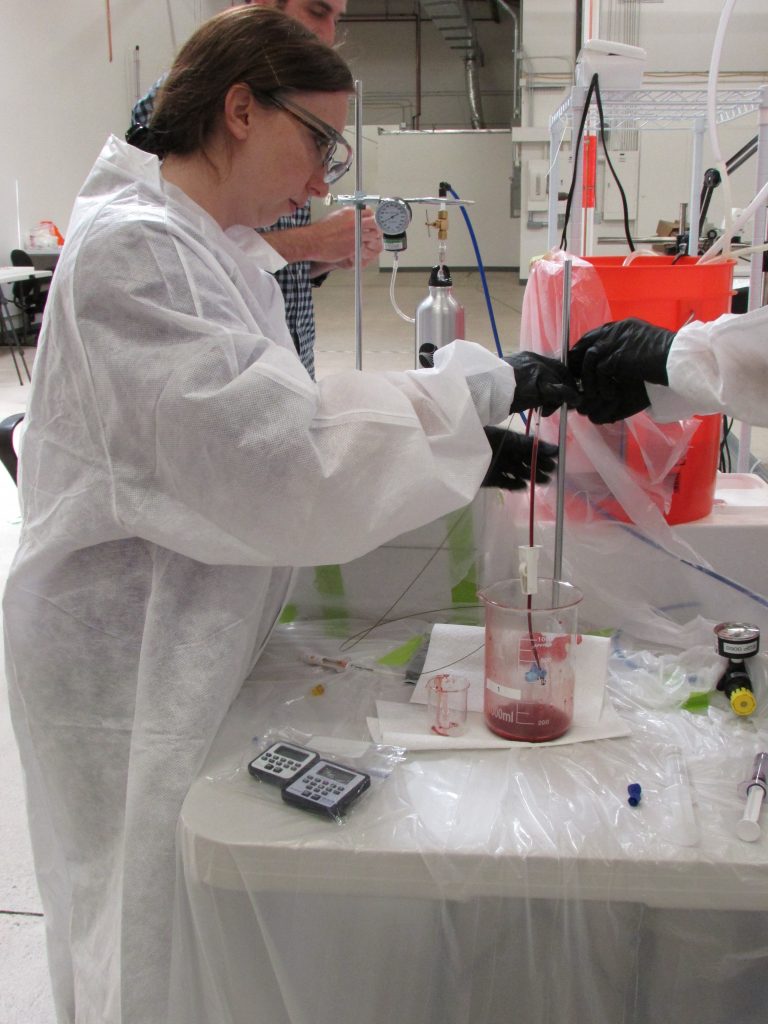
Informal Education PD Providers: Denver Museum of Nature & Science
Within the Institute’s RET program, teacher professional development is an area where the Institute contracts with other organizations for support. As director of the program, Meg John knows she cannot do it alone and makes use of resources from other partners, allowing other informal institutions to lend their expertise and resources. Informal organizations can respond to programming needs quickly; they are more flexible and not bound by district guidelines or requirements, so they can adjust and adapt content to make the trainings more relevant. Since Colorado has not yet adopted the NGSS, informal organizations provide an open venue for teachers to learn and apply the components of the NGSS in their professional training—a driving tenet of this RET program.
The Institute employs several avenues of support, partnering with the Denver Museum of Nature & Science to capitalize on their educational staff, exhibits, and scientists (Figure 6). They also take advantage of seeking the assistance of a few of the industry partners that can provide tours, background information on research, or at the very least a venue to host programming. In addition, the Institute uses a local STEM education consultant to coordinate content and to ensure that there is continuity and coherence across the PD sessions over the course of a year.
Figure 6
Tim Blesse, Teacher Programs Coordinator at the Denver Museum of Nature & Science, facilitates a photosynthesis lab by helping students construct their own investigations into the process.
Partners like the Denver Museum of Nature & Science benefit from the program by getting a glimpse of what is currently happening in STEM industries. It gives the museum an opportunity to develop more ways to help teachers translate their experiences to the classroom using tools and approaches for student-run investigations. These investigations scaffold thinking such as Argument Driven Inquiry, where students are taken through a process of building an argument and communicating and refining their claims based on peer feedback, just like scientists do. The museum focuses on providing effective PD based on current trends and practices supported by the research referenced in Relating Research to Practice (King 2013). Some examples of important aspects to include in professional development programs are:
- Clear focus
- Targeted activities for participants
- Inquiry-based and collaborative learning
- A design appropriate for the program’s duration and for sustainability
- Coherence of goals and design
- Alignment with school management and organizational conditions
Sessions at the museum help teachers implement the NGSS practices. “Explanation and Argumentation are two of the most complex things we expect students to do,” says Tim Blesse, Teacher Programs Coordinator at the museum. “Teachers are not given a lot of guidance in how to scaffold these processes for themselves or for their students. Claims, Evidence, and Reasoning (CER) and the previously mentioned approach, Argument Driven Inquiry (ADI) are two tools that teachers can use to simultaneously engage their students while helping them build and improve their skills as budding scientists.”
During RET PD sessions, the museum’s classroom walls are covered with large posters. Teachers are given a challenge to design a coating for the outside of the pill that withstands the acidic conditions of the stomach. The posters map the template they can use with their students to scaffold claims, evidence, and reasoning statements based on their designs. Teachers noisily work in small groups, crafting their scientific explanations onto posters using the CER framework. In a gallery walk that follows, the teachers look at what other groups have written, prompting each other with questions using an ADI protocol to help each other revise and refine their arguments (Figure 7).
Figure 7
Teachers in a PD session use an Argument Driven Inquiry (ADI) template during a lab investigation.
As our understanding of how to teach the NGSS practices grows, informal and formal PD providers can work together to support teachers by providing authentic examples of classroom instruction that helps students learn about the real-world application of science in action.
Student Impact
The Institute has also placed a greater emphasis on selecting teachers from schools that serve students in low-income districts, providing high-risk, high-need students with opportunities for science learning that they might not seek or have access to on their own. The hope is that the RET program will positively increase underrepresented students’ interest in STEM subjects and STEM careers.
When RET teachers are able to connect students directly to companies through field trip experiences, the impacts are even greater. For example, a bioscience company invited 16 students to participate in a behind-the-scenes tour and hands-on lab activity. After the visit, one student said the experience made her want to “keep going to school.” Another student was “inspired to do something that helps people.”
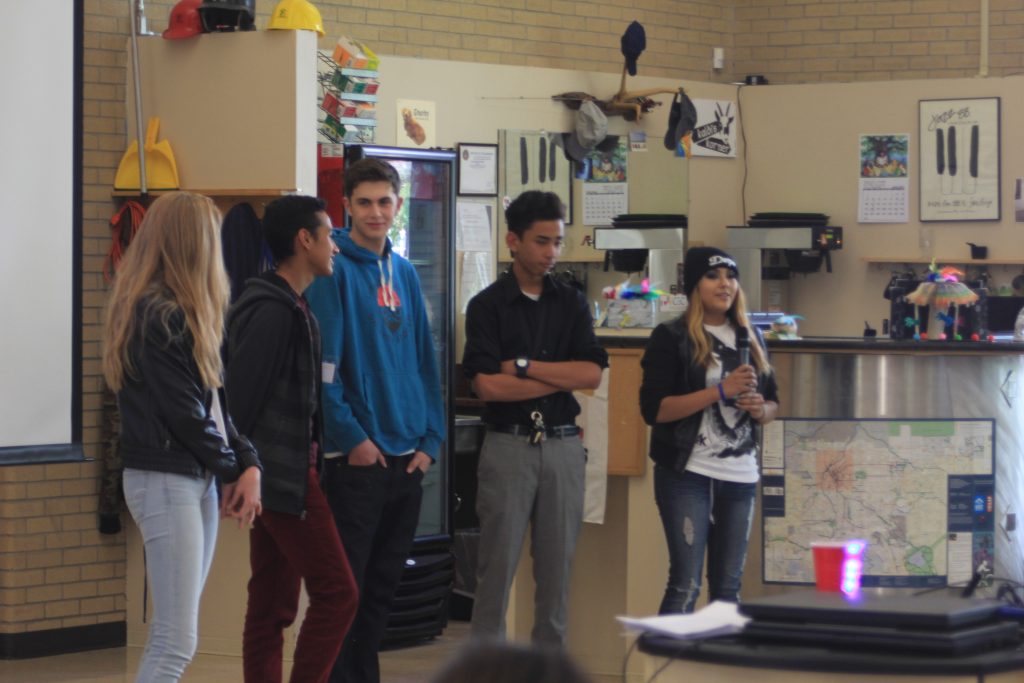
Students from another school participated in a sponsored engineering design challenge, learning firsthand what it’s like to work in a bioscience company. Using high-intensity lights as an adhesive, these students learned how to create guiding catheters. Working with the engineers, the students were able to ask questions, review failures, rework designs, and then take their finished product home to share with their families. Although students had opportunities to work with these engineering process steps in the past, their learning was greatly enhanced by working directly with professional engineers, encouraging them to ask more questions and practice framing their questions in different ways and helping them step outside of their typical school learning experience.
Challenges and Lessons Learned
The greatest strength of RET programs is that they create a new pathway for teachers to grow by collaborating with a variety of institutions, working together to connect teachers to real-world science. But before that can happen, RET programs face many challenges. The Colorado Bioscience Institute has grappled with many difficulties, learning lessons along the way that can benefit anyone who wants to start a RET program of their own. We describe a few of the major challenges below.
Funding
Challenge
Grant funding for such a small number of participants can be challenging since grantors often want to support programs that serve a larger number of people for wider impact. Currently, the Institute receives most of its funding support through local foundations and corporations. For those starting a RET program, a sizeable amount of seed money is needed, mostly to cover the large upfront costs of staffing and teacher stipends.
Lessons Learned
While some districts are eager to participate in the program, they may be less able or willing to offer up funding to support it. This means having to turn down certain districts even at the expense of a district’s strategic value as a partner. Partners must come into the program with money to support it. Districts are asked to pay about half of the cost per teacher—about $3,000. Often this money comes directly from the district or through joint grant-funding efforts to cover costs. Having districts pay a portion of the cost also increases their buy-in and commitment to support their teachers before, during, and after the RET experience. Funding support from participating companies also offsets costs. For the future, the Institute is also seeking larger federal grants to build greater capacity—another common challenge facing RET programs.
Capacity
Challenge
By the nature of the work itself, RET programs are limited in how much they can grow. Currently, the Institute’s program director, Meg John, works part-time as the sole staff member running the program. In addition, because of the one-on-one attention needed to support teachers, companies can only take a handful of teachers at a time. For a program serving 12 teachers, this means spreading participants over several companies, which in turn requires time and effort in cultivating relationships with each company.
Lessons Learned
The Institute uses other partners such as the Denver Museum of Nature & Science to provide staffing support for running teacher professional development. The museum sees its participation as mission-driven, viewing the RET program as an avenue to further its larger mission of being a catalyst for science in the community. Consequently, the museum absorbs a lot of their costs in staffing, program development, and overhead, only charging a small fee to the Institute to cover materials and food.
The Institute also calls upon the expertise of district science coordinators to support professional development and follow up with teachers. This support varies from district to district, with some districts able to support teachers more than others.
When coordinating with industry, the Institute seeks out companies, typically larger ones, that can host several teachers at a time. That being said, teachers often have richer experiences in smaller companies simply because smaller companies welcome the opportunity to increase their capacity and bring additional staff on board to work on projects.
Translating the RET Experience to the Classroom
Challenge
Simply put, it is difficult to directly translate the RET experience to the classroom. The research being done in the lab often relates to content that is too advanced or is not taught at the secondary level. While all the RET teachers who enter the program have a strong background in science education, their knowledge may still be limited compared to the research they are doing. Alternatively, the project may be focused on a STEM discipline outside of their expertise. For example, an Earth/environmental science teacher could end up working in a lab requiring a strong chemistry background.
There is also variability in each teacher’s RET experience. Some projects are more hands-on, with tasks that directly support the company, while others are given projects involving observations or simulation experiments without contributing to the company’s workload. Some of this limitation has to do with federal regulations or the amount of training it would require beyond the scope of the four-week window during which teachers are assigned to a site.
Because the RET experiences vary, some teachers have hands-on experiences that are more directly translatable to the classroom, primarily due to the type of work they are given and its relevance to classroom content. Eventually, all of the teachers find ways to translate the experience, as they often share their excitement from the experience with their students. The teachers also convey a more informed understanding of what science is like in the lab, allowing their students to know what this work is like in the real world.
When it comes to designing learning experiences for the classroom, there may be teachers who are less comfortable with developing lessons that are more student-directed or inquiry-oriented in a way that reflects how STEM research and development happen in the lab. Consequently, they need more assistance and possibly a change in mindset before they can shift their lesson planning in that direction.
Lessons Learned
It is not realistic for teachers to recreate what they did in their RET experience in the classroom, so focusing on the nature and structure of a self-directed student investigation is one way of helping teachers create relevant classroom experiences. Some RET programs use instructional models that give more of a framework for structuring a unit or lesson. For example, the RET programs at Vanderbilt University use the STAR Legacy Cycle to characterize the engineering process in a structure that is useful for developing curricula. The STAR Legacy Cycle is a challenge-driven model that follows the processes of engineering design: identifying a challenge, gathering multiple perspectives, researching and revising, testing, and sharing ideas and solutions with the public (Klein-Gardner, Johnston, and Benson 2012).
As mentioned earlier, the Institute uses the science and engineering practices as a starting point, because Colorado has not yet adopted the NGSS. While some teachers embrace the use of the practices, others have difficulty implementing them—less so in terms of including the practices, but more from incorporating them at the level of depth and complexity that the NGSS calls for at the secondary level. This year, the Institute, in partnership with DMNS, is providing professional development training for teachers to learn what types of tasks and processes are suitable for middle and high school students.
For district administrators, using tools that help assess changes in teaching practice can also help in the process. One tool we encountered in our research is the Reformed Teaching Observation Protocol or RTOP (Piburn and Sawada 2000), developed at Arizona State University. The protocol consists of an itemized list of instructional actions that demonstrate the use of student-directed modes of teaching. Interestingly enough, along with elements of good teaching and facilitation (such as encouraging active participation, higher proportion of students speaking in class), the list also mirrors aspects of the NGSS practices (communicating ideas, using models, argumentation). For more tools, please see the list of RET resources in Appendix A.
Evaluation
Challenge
There is great variability in how RET programs are run. This can be attributed to the fact that RET programs are very specific in the type of programming they offer and the needs and desired outcomes defined by the collaborators. Consequently, coming up with consistent measures from one RET program to another is challenging. Furthermore, quantifying and measuring change in teachers’ practice directly attributed to a RET experience is difficult to assess since other factors, like teacher attitude, resources, school culture and support systems, and variability in the RET experience itself, come into play. To date, while there are informative studies on the impact of RET programs, their numbers are few (Blanchard, Southerland, and Granger 2008; Capps, Crawford, and Constas 2012; Dixon and Wilke 2007; Hughes, Molyneaux, and Dixon 2012; Pop, Dixon, and Grove 2010). (For a short list of RET evaluative tools used in programs past and present, see Appendix B.)
Lessons Learned
In the future, the Institute is seeking additional grant funding to support other evaluative measures besides assessing the use of the SEPs and gathering data from teacher surveys, relying on current recommendations in the RET programming field.
Research tells us that one of the ways that change can be measured is by the type of learning interactions that happen in the classroom. For example, Miranda and Damico (2015) found that teachers who participated in RET programs reported that their experience enhanced students’ critical-thinking and problem-solving abilities, provided hands-on laboratory activities, helped prepare students for high-stakes tests, and strengthened the social aspects of inquiry-based instruction (e.g., case studies, group questioning). Furthermore, supporting the benefits of the RET program in translating the experiences of RET teachers to the classroom, Klein-Gardner, Johnston, and Benson (2012) found that participation in this program improved teaching strategies (e.g., using real-world context to incorporate interdisciplinary connections) and improved student motivation to learn science (e.g., students took a more active role in the classroom). In the future, inventories similar to the previously mentioned RTOP that bring greater specificity to the types of changes in teaching practice that are most likely to happen after a RET experience (e.g., use of real-world context in lessons) will be helpful. The Institute’s development of the tool it uses with the NGSS practices is an effort toward that end.
In terms of measuring teacher beliefs and attitudes, Ali Azar (2010) has developed a tool known as the Science Teaching Efficacy Belief Scale (STEBS) to determine a teacher’s level of self-efficacy in teaching and understanding science. The Institute will use this survey for pre- and post-assessment. Another factor Azar identified is a teacher’s level of “pedagogical discontentment,” or the level at which a teacher is satisfied (or dissatisfied) with their current and past practice. This satisfaction level can predict whether a teacher is likely to be open and willing to make changes in their teaching practice (Southerland, Sowell, and Enderle 2011; Southerland et al. 2011). A more in-depth review of how teacher beliefs and practice can influence change in the classroom can be found in a recent study led by Patrick Enderle (Enderle et al. 2014).
Conclusion
Overall, Colorado’s bioscience community has welcomed the chance to actively participate as part of the solution for improving the STEM pipeline. There is value in connecting teachers to scientists, but teachers may not feel comfortable engaging with scientists if they haven’t worked with them before. RET programs help teachers feel more at ease in making these connections happen (Pop, Dixon, and Grove 2010). Being immersed in a research environment helps teachers envision ways they can create a similar environment in their classrooms and encourages them to practice student-directed investigation (Miranda and Damico 2013).
STEM professionals also benefit from participating in RET programs because the teachers can provide a fresh set of eyes and an outsider’s viewpoint. As one mentor stated, “[Our teacher] intern saw all of our complex issues with a new set of eyes, offering a different perspective and awareness.” This change in perspective helps industry learn how to communicate with and educate the public better and, hopefully, through the teachers’ experience, inspire students to explore career pathways they might not know about.
For informal institutions, RET programs need an intermediary such as an informal organization to help coordinate programming, broker and sustain partnerships, and be responsive to collaborator needs and concerns. For industry partners, being a good community member can potentially lead to additional partnerships for other programs with districts or companies. These partnerships give informal educators a pathway to connect with key contacts within these companies for future partnerships and potential funding sources. Because the NGSS places an emphasis on real-world application and examples of science, this also provides informal educators with a window into STEM research and ways to incorporate real-world examples in their programming. Serving as an intermediary broker or contracted partner also affords informal educators with a more informed understanding of school districts and their needs and priorities, which can shape the direction of professional development programming and deepen the overall partnership with a school or district. For this particular project, the Denver Museum of Nature & Science has also used this program as an opportunity to delve into the NGSS standards, using the project to build our use and understanding of NGSS and in particular the practices and training teachers within the RET program and beyond.
In the case of the Colorado Bioscience Institute’s RET program, and many others like it, the collaboration of so many players proves that we can strengthen the STEM pipeline together, furthering our common goal of inspiring students to pursue STEM education and careers.
Robert Payo (Robert.Payo@dmns.org) is teacher programs coordinator at the Denver Museum of Nature and Science in Denver, Colorado. Meg John (mjohn@cobioscience.com) is the program director of the Colorado Bioscience Institute in Denver, Colorado.



